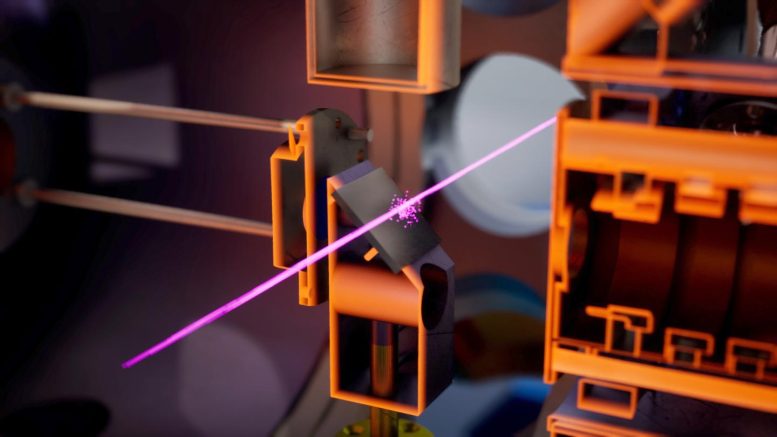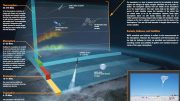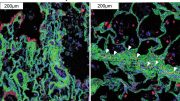
Positronium cooling. The AEgIS collaboration at CERN has experimentally demonstrated the laser cooling of positronium using an alexandrite-based laser system. Credit: CERN – Politecnico di Milano
Researchers successfully cooled positronium atoms, significantly impacting antimatter research and enabling new experiments in quantum electrodynamics and the potential for an antimatter Bose-Einstein condensate.
The international AEgIS (Antimatter Experiment: gravity, Interferometry, Spectroscopy) collaboration at CERN, in which Prof. Giovanni Consolati of the Department of Aerospace Science and Technology participates on behalf of the Politecnico di Milano, experimentally demonstrated, for the first time, positronium (Ps) laser cooling using a particular laser system (alexandrite-based), specifically developed to meet the requirements of cooling: high intensity, large bandwidth and long duration of the pulse.
The equivalent temperature of the Ps atoms exiting from a porous target (at room temperature) hit by a positron beam decreased from 380 K to 170 K, corresponding to a decrease of the transversal component of Ps rms velocity from 54 km/s to 37 km/s.
The Unique Nature of Positronium
Ps is a minor brother of hydrogen, with a positron replacing the proton. Consequently, it is lighter than hydrogen by about a factor 2000 and energy levels are reduced by a factor 2. It is unstable: in vacuum and in the ground state, with parallel spins of the two particles, it annihilates with a lifetime of only 142 ns. Ps cooling has to occur during its short lifespan and this makes the process so challenging with respect to ordinary atoms. Use of a large bandwidth pulsed laser has the advantage of cooling a large fraction of the positronium cloud while increasing their effective lifetime, resulting also in a higher number of Ps after cooling for further experimentation.
Implications for Antimatter Research
In the case of the AEgIS experiment, aiming to measure the gravitational acceleration of antihydrogen (as a test of the weak equivalence principle for antimatter), this last is obtained by means of a reaction between Ps in excited state and trapped antiprotons. The lower Ps velocity the higher the probability of antihydrogen formation, whence the importance to produce Ps with the lowest kinetic energy possible.
Advancing Basic Science and Potential Applications
Availability of sufficiently ‘cold’ Ps atoms is of the utmost importance for basic science, e.g. precision spectroscopy of Ps excited energy levels allowing test of quantum electrodynamics with unprecedent precision, or testing the equivalence principle with a purely leptonic system.
Furthermore, the possibility to set up an ensemble of cold Ps atoms could pave the way to the first antimatter Bose-Einstein condensate (BEC, already obtained by laser cooling ordinary atoms), a state at which quantum mechanical phenomena manifest macroscopically. A positronium BEC would entail stimulated annihilation, which has been proposed as a way to produce coherent electromagnetic radiation in the range of gamma ray energies.
The result has been published in Physical Review Letters as Editor’s Highlight.
Reference: “Positronium Laser Cooling via the 13S−23P Transition with a Broadband Laser Pulse” by 22 February 2024, Physical Review Letters.
DOI: 10.1103/PhysRevLett.132.083402









Please answer:
1. Is antimatter a chiral substance?
2. Is antimatter mirror matter?
3. Do high-dimensional spacetime matter have antimatter?
4. Do low dimensional spacetime matter have antimatter?
5. Is high-dimensional spacetime matter related to low-dimensional spacetime matter?
6. Are electrons high-dimensional spacetime matter or low-dimensional spacetime matter?
7. Is the so-called positive electron and negative electron absolutely symmetrical?
8. Can we study positive matter and antimatter without considering time?
9. Why are there positive matter and antimatter?
10. Are so-called academic journals (such as Physical Review Letters, Nature, Science, etc.) scientific and honest?
and so on.
Today, we have already entered the era of the internet. With the help of artificial intelligence and big data, discussions on scientific knowledge have become open and transparent. However, a group of editors of so-called academic journals (such as Physical Review Letters, Nature, Science, etc.) are mystifying themselves. They only care about their own so-called sufficiently high priority rating, general significance, discipline, novelty, etc., and do not care about what science and pseudoscience are.
Science and pseudoscience are not determined by a publication, an organization or a person, nor by you or me, but by mathematics the final say. Physical models must be based on mathematics or mathematical models in order to be scientific, convincing, and in accordance with natural laws.
The branch of mathematics known as topology has become a cornerstone of modern physics. The perpetually swirling topological vortices defy traditional physics’ expectations. A physical properties of topological vortices is their to spontaneously begin to change periodically in time, even though the system does not experience corresponding periodic interference. Therefore, in the interaction of topological vortices, time is both absolute and relative,and physics often requires treating space and time at the same level.
Low-dimensional spacetime matter is the foundation of high-dimensional spacetime matter. Low-dimensional spacetime matter (such as topological vortex) can form new material structures and derive more complex physical properties via interactions and self-organization. It is extremely wrong and irresponsible to imagine low dimensional spacetime matter using high-dimensional spacetime matter.
Science must follow mathematical rules. For example, the Standard Model (SM) is considered to be one of the most significant achievements of physics in the 20th century. However, the magnetic moment of μ particle is larger than expected, revealed by a g-2 experiment at Fermilab, suggests that the established theory (such as SM) of fundamental particles is incomplete. Furthermore, the SM omitting gravitation, it not involved the time problem and when the particle movement starts. Mathematics is the foundation of science. Physics must respect the scientific nature of mathematics and mathematical models. The SM must be based on mathematical models in order to be scientific, convincing, and in line with natural laws.
I hope researchers are not fooled by the pseudoscientific theories of the Physical Review Letters (PRL), and hope more people dare to stand up and fight against rampant pseudoscience.
The so-called academic journals (such as Physical Review Letters, Nature, Science, etc.) firmly believe that two high-dimensional spacetime objects (such as two sets of cobalt-60) rotating in opposite directions can be transformed into two objects that mirror each other, is a typical case of pseudoscience rampant.
If researchers are really interested in Science and Physics, you can browse https://zhuanlan.zhihu.com/p/643404671 and https://zhuanlan.zhihu.com/p/595280873.
The result has been published in Physical Review Letters as Editor’s Highlight.
Please answer:
1. Are the observed antihydrogen atoms and hydrogen atoms in the experiment high-dimensional spacetime matter or low-dimensional spacetime matter?
2. How to define and observe the antimatter of high-dimensional spacetime matter?
3. Do we not consider time when defining matter and antimatter?
The Shame of Contemporary Physics and Science
If mathematics and mathematical models are scientific, according to topological vortex gravitational field theory, studying matter and antimatter in high-dimensional spacetime will be extremely difficult. Matter and antimatter must exhibit parity conservation, charge conjugation, and time reversal symmetry, all of which are indispensable.
Ask Physical Review Letters (PRL) to answer:
1. Are topological vortices and their antivortices gravitational fields?
2. Do topological vortices and their antivortices exhibit parity conservation, charge conjugation, and time reversal symmetry?
3. Why are θ & τ the same particle?
4. Can two sets of cobalt-60 rotate in reverse to form a mirror image of each other?
and so on.
1. Can the answers been published in Physical Review Letters (PRL) as Editor’ s Highlight?
2. Is Physical Review Letters (PRL) Adhering to Science?
This is just the dirty and ugly tip of the iceberg in contemporary physics.